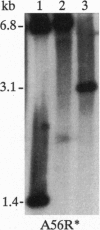Abstract
The squamous cell carcinoma antigen (SCCA) is a member of the ovalbumin family of serine proteinase inhibitors (serpins). A neutral form of the protein is found in normal and some malignant squamous cells, whereas an acidic form is detected exclusively in tumor cells and in the circulation of patients with squamous cell tumors. In this report, we describe the cloning of the SCCA gene from normal genomic DNA. Surprisingly, two genes were found. They were tandemly arrayed and flanked by two other closely related serpins, plasminogen activator inhibitor type 2 (PAI2) and maspin at 18q21.3. The genomic structure of the two genes, SCCA1 and SCCA2, was highly conserved. The predicted amino acid sequences were 92% identical and suggested that the neutral form of the protein was encoded by SCCA1 and the acidic form was encoded by SCCA2. Further characterization of the region should determine whether the differential expression of the SCCA genes plays a causal role in development of more aggressive squamous cell carcinomas.
Full text
PDF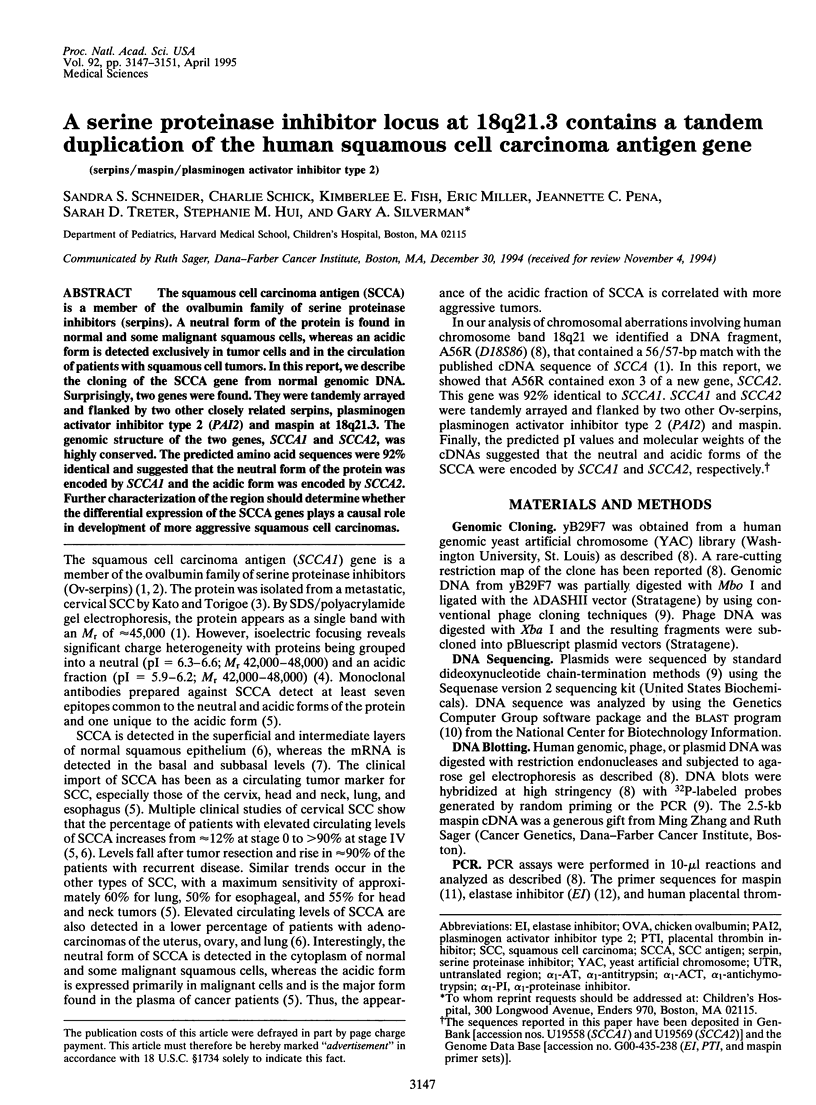
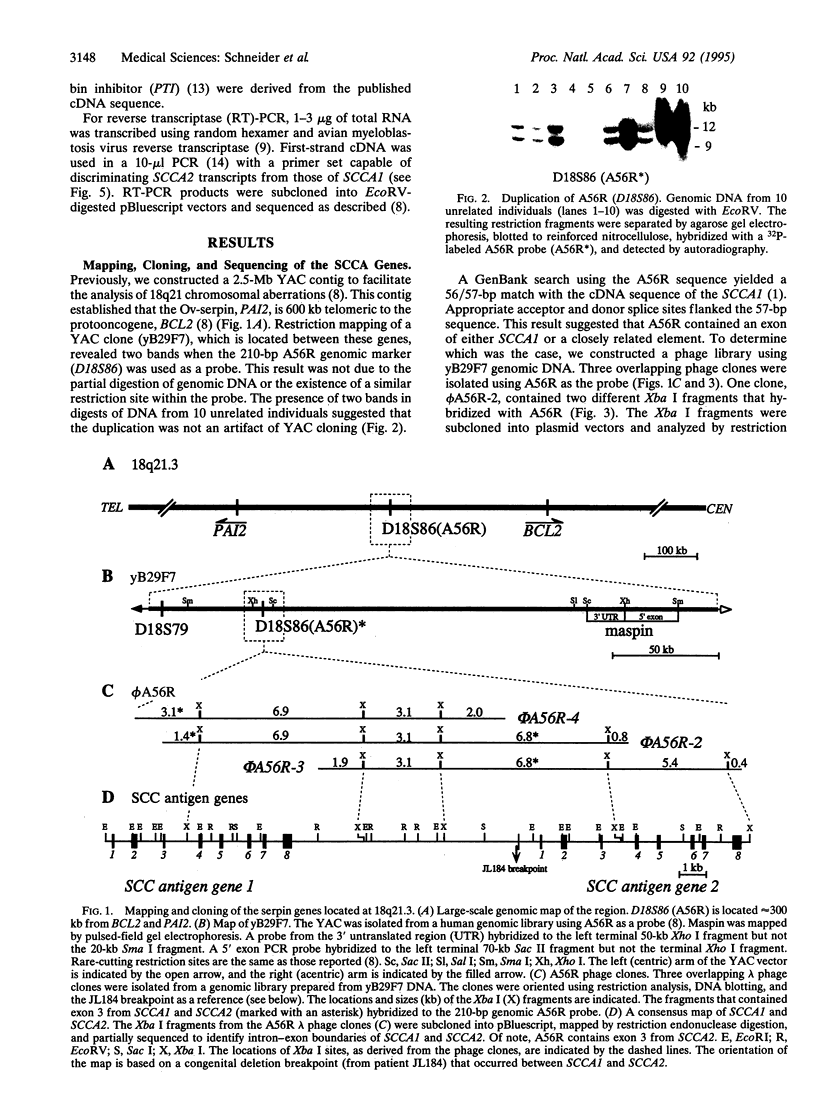
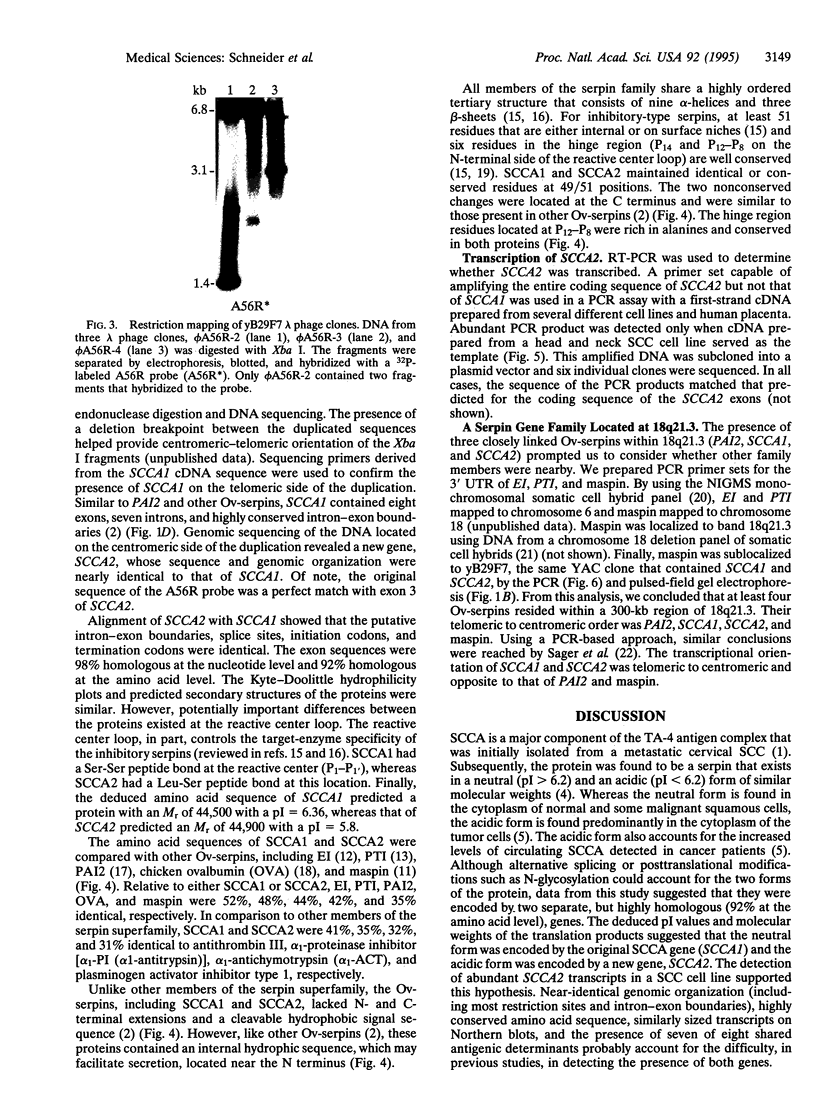
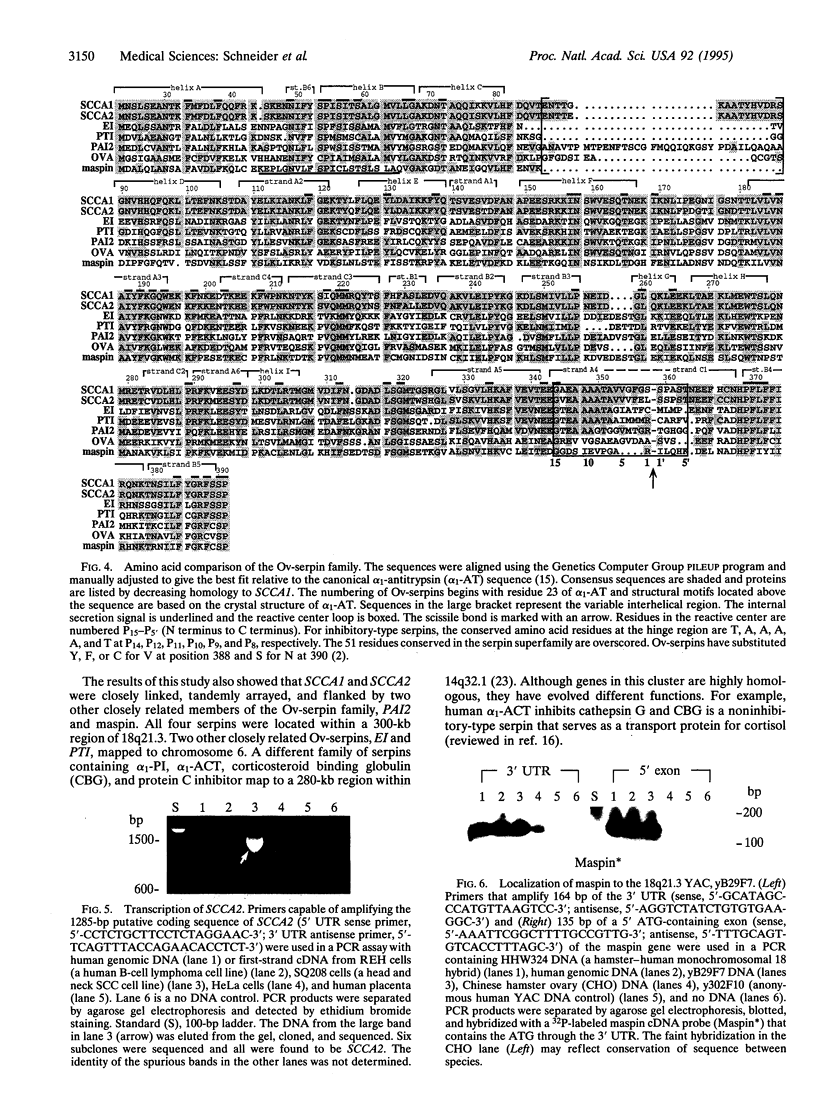
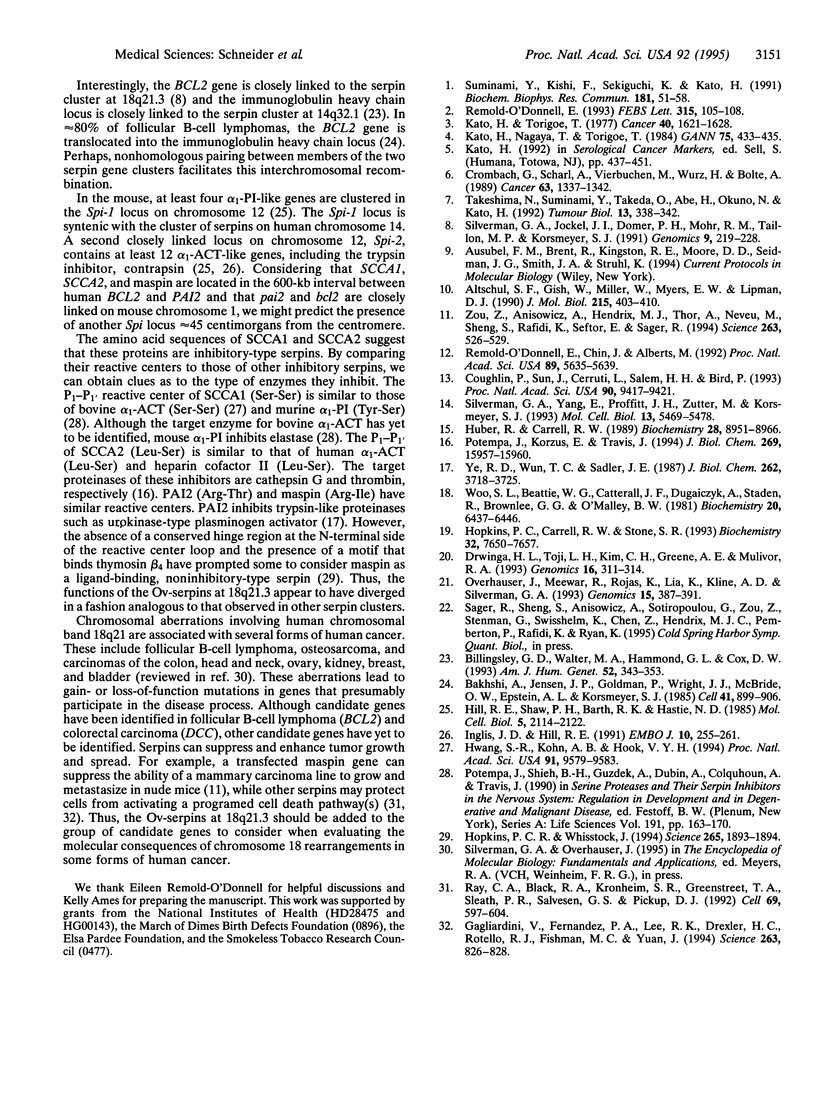
Images in this article
Selected References
These references are in PubMed. This may not be the complete list of references from this article.
- Altschul S. F., Gish W., Miller W., Myers E. W., Lipman D. J. Basic local alignment search tool. J Mol Biol. 1990 Oct 5;215(3):403–410. doi: 10.1016/S0022-2836(05)80360-2. [DOI] [PubMed] [Google Scholar]
- Bakhshi A., Jensen J. P., Goldman P., Wright J. J., McBride O. W., Epstein A. L., Korsmeyer S. J. Cloning the chromosomal breakpoint of t(14;18) human lymphomas: clustering around JH on chromosome 14 and near a transcriptional unit on 18. Cell. 1985 Jul;41(3):899–906. doi: 10.1016/s0092-8674(85)80070-2. [DOI] [PubMed] [Google Scholar]
- Billingsley G. D., Walter M. A., Hammond G. L., Cox D. W. Physical mapping of four serpin genes: alpha 1-antitrypsin, alpha 1-antichymotrypsin, corticosteroid-binding globulin, and protein C inhibitor, within a 280-kb region on chromosome I4q32.1. Am J Hum Genet. 1993 Feb;52(2):343–353. [PMC free article] [PubMed] [Google Scholar]
- Coughlin P., Sun J., Cerruti L., Salem H. H., Bird P. Cloning and molecular characterization of a human intracellular serine proteinase inhibitor. Proc Natl Acad Sci U S A. 1993 Oct 15;90(20):9417–9421. doi: 10.1073/pnas.90.20.9417. [DOI] [PMC free article] [PubMed] [Google Scholar]
- Crombach G., Scharl A., Vierbuchen M., Würz H., Bolte A. Detection of squamous cell carcinoma antigen in normal squamous epithelia and in squamous cell carcinomas of the uterine cervix. Cancer. 1989 Apr 1;63(7):1337–1342. doi: 10.1002/1097-0142(19890401)63:7<1337::aid-cncr2820630719>3.0.co;2-j. [DOI] [PubMed] [Google Scholar]
- Drwinga H. L., Toji L. H., Kim C. H., Greene A. E., Mulivor R. A. NIGMS human/rodent somatic cell hybrid mapping panels 1 and 2. Genomics. 1993 May;16(2):311–314. doi: 10.1006/geno.1993.1190. [DOI] [PubMed] [Google Scholar]
- Gagliardini V., Fernandez P. A., Lee R. K., Drexler H. C., Rotello R. J., Fishman M. C., Yuan J. Prevention of vertebrate neuronal death by the crmA gene. Science. 1994 Feb 11;263(5148):826–828. doi: 10.1126/science.8303301. [DOI] [PubMed] [Google Scholar]
- Hill R. E., Shaw P. H., Barth R. K., Hastie N. D. A genetic locus closely linked to a protease inhibitor gene complex controls the level of multiple RNA transcripts. Mol Cell Biol. 1985 Aug;5(8):2114–2122. doi: 10.1128/mcb.5.8.2114. [DOI] [PMC free article] [PubMed] [Google Scholar]
- Hopkins P. C., Carrell R. W., Stone S. R. Effects of mutations in the hinge region of serpins. Biochemistry. 1993 Aug 3;32(30):7650–7657. doi: 10.1021/bi00081a008. [DOI] [PubMed] [Google Scholar]
- Hopkins P. C., Whisstock J. Function of maspin. Science. 1994 Sep 23;265(5180):1893–1894. [PubMed] [Google Scholar]
- Huber R., Carrell R. W. Implications of the three-dimensional structure of alpha 1-antitrypsin for structure and function of serpins. Biochemistry. 1989 Nov 14;28(23):8951–8966. doi: 10.1021/bi00449a001. [DOI] [PubMed] [Google Scholar]
- Hwang S. R., Kohn A. B., Hook V. Y. Molecular cloning reveals isoforms of bovine alpha 1-antichymotrypsin. Proc Natl Acad Sci U S A. 1994 Sep 27;91(20):9579–9583. doi: 10.1073/pnas.91.20.9579. [DOI] [PMC free article] [PubMed] [Google Scholar]
- Inglis J. D., Hill R. E. The murine Spi-2 proteinase inhibitor locus: a multigene family with a hypervariable reactive site domain. EMBO J. 1991 Feb;10(2):255–261. doi: 10.1002/j.1460-2075.1991.tb07945.x. [DOI] [PMC free article] [PubMed] [Google Scholar]
- Kato H., Nagaya T., Torigoe T. Heterogeneity of a tumor antigen TA-4 of squamous cell carcinoma in relation to its appearance in the circulation. Gan. 1984 May;75(5):433–435. [PubMed] [Google Scholar]
- Kato H., Torigoe T. Radioimmunoassay for tumor antigen of human cervical squamous cell carcinoma. Cancer. 1977 Oct;40(4):1621–1628. doi: 10.1002/1097-0142(197710)40:4<1621::aid-cncr2820400435>3.0.co;2-i. [DOI] [PubMed] [Google Scholar]
- Overhauser J., Mewar R., Rojas K., Lia K., Kline A. D., Silverman G. A. STS map of genes and anonymous DNA fragments on human chromosome 18 using a panel of somatic cell hybrids. Genomics. 1993 Feb;15(2):387–391. doi: 10.1006/geno.1993.1072. [DOI] [PubMed] [Google Scholar]
- Potempa J., Korzus E., Travis J. The serpin superfamily of proteinase inhibitors: structure, function, and regulation. J Biol Chem. 1994 Jun 10;269(23):15957–15960. [PubMed] [Google Scholar]
- Ray C. A., Black R. A., Kronheim S. R., Greenstreet T. A., Sleath P. R., Salvesen G. S., Pickup D. J. Viral inhibition of inflammation: cowpox virus encodes an inhibitor of the interleukin-1 beta converting enzyme. Cell. 1992 May 15;69(4):597–604. doi: 10.1016/0092-8674(92)90223-y. [DOI] [PubMed] [Google Scholar]
- Remold-O'Donnell E., Chin J., Alberts M. Sequence and molecular characterization of human monocyte/neutrophil elastase inhibitor. Proc Natl Acad Sci U S A. 1992 Jun 15;89(12):5635–5639. doi: 10.1073/pnas.89.12.5635. [DOI] [PMC free article] [PubMed] [Google Scholar]
- Remold-O'Donnell E. The ovalbumin family of serpin proteins. FEBS Lett. 1993 Jan 4;315(2):105–108. doi: 10.1016/0014-5793(93)81143-n. [DOI] [PubMed] [Google Scholar]
- Silverman G. A., Jockel J. I., Domer P. H., Mohr R. M., Taillon-Miller P., Korsmeyer S. J. Yeast artificial chromosome cloning of a two-megabase-size contig within chromosomal band 18q21 establishes physical linkage between BCL2 and plasminogen activator inhibitor type-2. Genomics. 1991 Feb;9(2):219–228. doi: 10.1016/0888-7543(91)90245-a. [DOI] [PubMed] [Google Scholar]
- Silverman G. A., Yang E., Proffitt J. H., Zutter M., Korsmeyer S. J. Genetic transfer and expression of reconstructed yeast artificial chromosomes containing normal and translocated BCL2 proto-oncogenes. Mol Cell Biol. 1993 Sep;13(9):5469–5478. doi: 10.1128/mcb.13.9.5469. [DOI] [PMC free article] [PubMed] [Google Scholar]
- Suminami Y., Kishi F., Sekiguchi K., Kato H. Squamous cell carcinoma antigen is a new member of the serine protease inhibitors. Biochem Biophys Res Commun. 1991 Nov 27;181(1):51–58. doi: 10.1016/s0006-291x(05)81380-4. [DOI] [PubMed] [Google Scholar]
- Takeshima N., Suminami Y., Takeda O., Abe H., Okuno N., Kato H. Expression of mRNA of SCC antigen in squamous cells. Tumour Biol. 1992;13(5-6):338–342. doi: 10.1159/000217784. [DOI] [PubMed] [Google Scholar]
- Woo S. L., Beattie W. G., Catterall J. F., Dugaiczyk A., Staden R., Brownlee G. G., O'Malley B. W. Complete nucleotide sequence of the chicken chromosomal ovalbumin gene and its biological significance. Biochemistry. 1981 Oct 27;20(22):6437–6446. doi: 10.1021/bi00525a024. [DOI] [PubMed] [Google Scholar]
- Ye R. D., Wun T. C., Sadler J. E. cDNA cloning and expression in Escherichia coli of a plasminogen activator inhibitor from human placenta. J Biol Chem. 1987 Mar 15;262(8):3718–3725. [PubMed] [Google Scholar]
- Zou Z., Anisowicz A., Hendrix M. J., Thor A., Neveu M., Sheng S., Rafidi K., Seftor E., Sager R. Maspin, a serpin with tumor-suppressing activity in human mammary epithelial cells. Science. 1994 Jan 28;263(5146):526–529. doi: 10.1126/science.8290962. [DOI] [PubMed] [Google Scholar]




